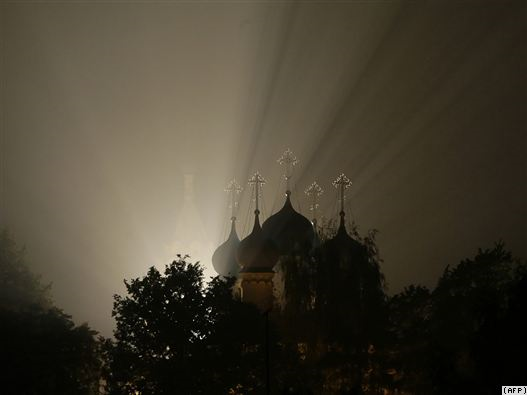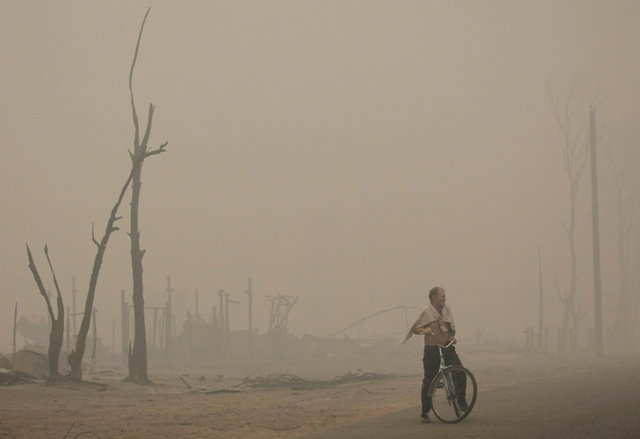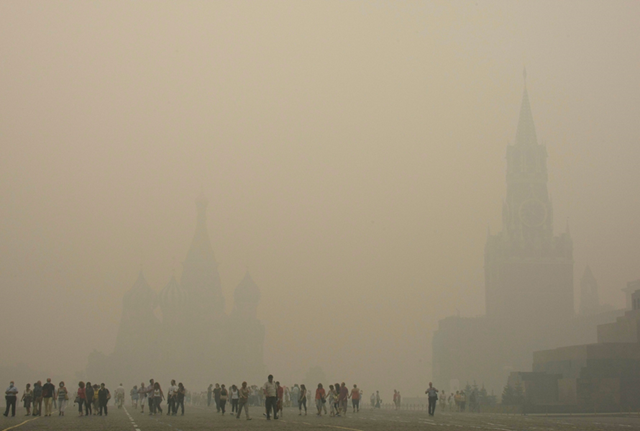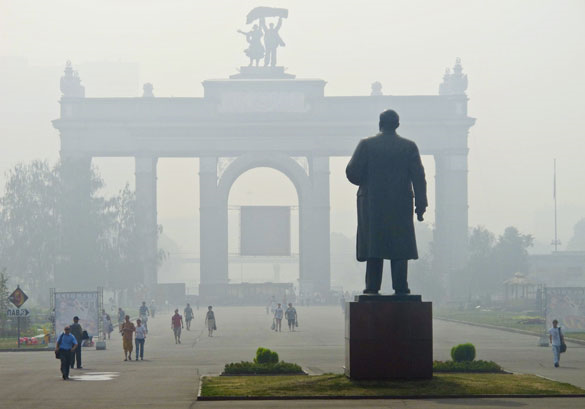Pollution level goes up as Russia battles fires
IANS
7 August 2010 Visibility in some parts of Moscow dropped to below 50 metres and air pollution reached more than six times normal levels Saturday, as Russia battled more than 300 new wildfires in a span of 24 hours alone, the Interfax news agency reported. Most of the new fires were rapidly extinguished, the Civil Defence Ministry told Interfax. Nevertheless, some 840 forest and peat bog fires burned on across Russia. The smog blanketing Moscow will not disperse until at least Wednesday, meteorologists said. Doctors in the capital warned of serious health problems, as hundreds of people turned up at hospitals with smog-related ailments. The smoke has even made its way into the shafts of the capital’s renowned metro, which reach up to 85 metres underground. Simple surgical masks are of no help, health expert Leonid Lazebnik warned. Officials called on Moscow residents to stay indoors or even leave the city altogether. … Hundreds of thousands of firefighters, soldiers and volunteers continued to fight the country’s devastating blazes, sometimes with primitive resources. Thick smoke repeatedly blocked attempts to douse the flames from the air. The fires are now to be fought around the clock, Deputy Minister of Civil Defence Alexander Chupriyan declared Saturday. Until now, they had only been contained at night. … Russia has been in the grip of record heat, with temperatures of around 40 degrees Celsius, and a drought unmatched in a century. …
Pollution level goes up as Russia battles fires 
The Associated Press
Saturday, August 7, 2010 | 6:24 PM ET A suffocating smog from wildfires hung over the Russian capital Saturday, raising the concentration of dangerous pollutants to a new high as exasperated residents donned masks and dozens of flights were delayed or diverted at the city’s airports. The thick haze engulfed Moscow for a second straight day as southeastern winds blew smoke from the areas worst affected by peat bog and forest fires. Weather experts said the winds are unlikely to change over the next few days. The concentration of air-borne pollutants such as carbon monoxide has further intensified and is at more than six times normal levels — the worst seen to date in Moscow — according to city health officials. The smog has seeped into buildings and the city’s subway system. “I can’t bear it any more,” said Anna Kozyreva, 25. “My parents have left the city. All I want to is breathe normally, but my job doesn’t allow me to leave.” “The smoke is everywhere — at home, in shopping malls, on the subway,” added Roman Morozov, a 29-year-old architect. …
Smog blanket worsens in Moscow 
MOSCOW (AP) — A choking smog from raging wildfires shrouded Moscow on Friday, grounding flights, plunging the city’s iconic Red Square into a sea of dirty mist and stinging eyes and throats across the Russian capital. Flocks of tourists had to don face masks just to tread the square’s historic cobblestones, straining to photograph the Kremlin’s barely visible spires and the hazy domes of St. Basil’s Cathedrals. Dozens of flights were grounded and others were diverted away from the capital’s Domodedovo and Vnukovo airports, as smog brought runway visibility down to 220 yards (200 meters), officials said. More than 500 separate blazes were burning nationwide Friday, mainly across western Russia, amid the country’s most intense heat wave in 130 years. At least 52 people have died and 2,000 homes have been destroyed in the blazes. Russian officials have admitted that the 10,000 firefighters battling the blazes aren’t enough — an assessment echoed by many villagers, who said the fires swept through their hamlets in minutes. (26 images)
Russian Wildfires Continue to Burn 
St. Basil’s Cathedral, left, and the Kremlin, right, are seen as tourists walk through thick smog at Red Square in Moscow, Russia, Friday, Aug. 6, 2010. AP Photo / Mikhail Metzel
The view from the seventh floor of a building in Kolomna, outside Moscow, on August 4, 2010. RIA Novosti

